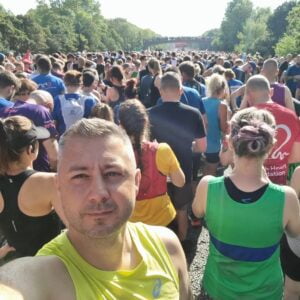I’m a Multi-marathoner!
Success! I can now call myself a multi-marathoner! Granted I’ve only ran two marathons but hey, it’s more than one and there’ll be more to come. It’s also major progress towards my Iron Man triathlon ambition.
It’s been a while since my last blog update, mainly down to having to focus on marathon training, now 5-month-old twins and a demanding 3 year old plus the usual stuff, full time job blah blah….
I’ll get to the marathon success shortly as I’m feeling pretty good about my achievements this year and haven’t updated anything about my Great North Run 2015 experience. In summary I was aiming for a sub 2 hour finish time and all my training was telling me that it was possible, however I’ve been there before. Last year I was predicting a sub 2 hour finish in the same race and ended up suffering from three crazy hypos leaving me a gibbering wreck and a finish time of 2 hrs 10 mins when I know I could’ve gone much quicker. One of the main differences between last year and this year has been my move to an insulin pump which has given me so much more flexibility in managing my basal insulin rate and allowed me to reduce the risk of hypo during exercise.
Great North Run 2015
Well, I smashed the 2 hour target with a finishing time of 1 hr 52 mins!! I’m really happy with that, it’s progress and it’s a new half marathon PB for me, including my pre-diabetic times!! I didn’t suffer any hypos and my blood glucose stayed between 5 – 8 mmol the whole race. My first thought was “could I run that any quicker?” the answer being “not right now”. With a bit more time to give proper focus to my training I think I could run a lot quicker, dare I say it, maybe into the sub 1:40 times. The fact that I’m even thinking about those times shows how far I’ve come and how much I’ve learned about managing my type 1 diabetes during exercise over these past couple of years. This year I was so much more confident that my blood glucose levels would be fine during the race it gave me some thinking space for how I’d actually run the race to the best of my abilities. I’ve not experienced that feeling since before my diagnosis in 2012 and let me tell you, it really is a great feeling! This feeling can be attributed to five things.
5 things that helped me become a multi-marathoner!
1. Trial and Error
I’ve tinkered with my basal rates prior to going out for a run and settled on setting a 20% basal rate (or minus 80%) between 1 – 2 hours prior to setting off on my run. I take on 15 – 20g of fast acting carb every 30 minutes in the form of dextrose powder mixed with water or energy gel. This has got me safely through regular runs of up to 20 miles without experiencing low or high blood glucose.
2. Peer Support
I’m fairly active on social media and particularly on the Sporty Type 1 Diabetics, Team Blood Glucose and GBDOC Facebook pages. The ability to ask a question related to exercising with type 1 diabetes and get a pretty instant answer from someone who knows is absolutely amazing and can’t be underestimated. I’ve always felt welcome and supported within these groups and really can’t recommend them enough. If you want to ask a question, just ask. If you want to spectate and see what others are asking, spectate. It’s great! Also add me on Twitter, it’s a brilliant platform for peer support.
3. Moving from multiple daily injections (MDI) to an insulin pump
When I was on injections I had to reduce my long acting insulin (Lantus) the evening before exercise. My main problem was my insulin sensitivity, a reduction down to just 4 units of Lantus still wasn’t reducing my chances of hypo as much as I wanted, even with taking on 60g of carbs per hour! My Animas Vibe insulin pump has pretty much cured this and a 20% basal rate combined with 30 – 40g carb per hour is working pretty well for me.
4. Continuous Glucose Monitoring (CGM)
Ok, it’s not cheap and I really wish us type 1’s in the UK could get it on the NHS but it has made such a difference to my management of my diabetes. I decided to take the leap and invest in a Dexcom G4 Platinum CGM system last year. My budget allows me to buy one sensor per month however long I get out of that sensor (I average around 21+ days from each sensor). The CGM readings have given me an amazing insight into what is happening with my blood glucose levels during exercise. This combined with the ability to change my temporary basal rate on my pump has given me so much more confidence that my blood glucose levels will behave.
5. xDrip
“What’s xDrip?” I hear you ask. Well, xDrip is pretty amazing, it originated through part of the #WeAreNotWaiting movement and was created by a very clever man called Stephen Black from over in the USA.
In summary xDrip is two things:
- A small DIY home built gadget which picks up the Bluetooth signal and readings from my Dexcom CGM transmitter and sends them onto my android smartphone.
- An android app that displays the CGM readings and has the ability to send them to an internet cloud based site called Nightscout so others can remotely view the readings too. In my case my wife when I’m out on my long runs.
My android xDrip app also sends my CGM readings to my Sony Smartwatch 3 via an app called Nightwatch so I can simply check my watch for my blood glucose levels when running or cycling, how amazing is that!! If you have any questions about xDrip just drop them into the comments box or check out the really useful info here:
- xDrip website from Stephen Black
- A Dummy’s Guide to Building an xDrip from Kev Winchcombe
- Nightscout website


Yorkshire Marathon 2015
My aim for the marathon was to run under 4 hrs 30 mins following a horrific experience completing the 2013 Yorkshire Marathon in 5 hrs 20 min after my blood glucose meter failed and I overdid the energy gels resulting in a spell with St. John’s Ambulance and a “HI” blood glucose reading.
My training was pointing to a finish time of around 4hrs 15 min but my final preparations were thrown into chaos when one of the twins was admitted to hospital and kept in for a couple of days. She’s fine now and it turned out to be a false alarm but did result in next to no sleep for the 48 hours prior to the marathon. I also broke the golden rule of “don’t do anything new on race day” by taking Imodium for a bit of a dodgy tummy, the result being pretty bad stomach cramps from mile 9. I finished with good blood glucose levels and a time of 4 hrs 46 mins. Outside of my target but a new marathon PB and as fast as I could run on the day given the final prep. The sub 4 hr 30 mins will come, as will a sub 4 hrs I’m sure.
The Plan for Next Year
Next year will involve my first foray into competitive triathlon with an ultra-marathon thrown in towards the end of the year! Thanks for all the support on the Facebook groups and Twitter, it keeps me motivated and inspired to achieve that ambition of becoming an Iron Man.









Another great blog Craig! It never fails to amaze me how different us T1’s are…I reduce my basal by 20% (compared to your reduction of 80%!) during long runs so quite a comparison! But then u said that was what u did 1-2 hrs before runs so what do u do during runs?
Good question Joanne. I keep that 20% basal until 30 mins before the end of my long run then take basal back to 100%. I also bolus 2 units straight after my run to reduce post exercise spike.
So if the xdrip picks up the signal from the dexcom transmitter then bluetooths it to your device what’s to stop an apple device picking the Bluetooth signal up?
Hi Tom – Good question and one I’m not able to answer other than to say “something is stopping an apple device picking it up or being able to understand what is sent”. If that wasn’t the case there would be an apple option for xdrip I’m sure.
The obvious alternative for those in the USA is the dexcom G5 which works directly with apple devices and is due to work with android devices in the future.
hi, love to hear about your fantastic BGs and marathon running. My son is 8 with type 1 and stories like yours give me such optimism for his future. xDrip is just what we are thinking he needs to give him more freedom without adults tailing him everywhere he goes and I love the way this remote monitoring comes in such a small package. Our funded G4 will not be upgraded to a G5 by NHS in the near future so I think xDrip is the way forward. When you run how do you carry the device and smartphone? He has a SPIbelt for his Dex and it allows for all the rough and tumble and sport he loves. Be good if he didn’t need a much bigger bag.
Hi Anna
Apologies for the super late response, your comment was caught in the spam folder for some reason! xDrip has been fantastic for me, the ability to see my BG on my watch is great. As an adult my smartphone fits in my running shorts back pocket or on my long runs I wear a hydration vest with lots of pockets on it or a running belt with a front pocket and gel loops on it from iFitness. The xDrip I use is sat inside a tic tac box so super small and fits in my pocket or running belt right alongside my phone.